Further to my articles Sea urchin barrens and mini-barrens and Follow-up re Sea urchin barrens and mini-barrens, when Chris Roberts posted this photo of Red-tipped Urchins, Heliocidaris tuberculata, seen at Little Bay, New South Wales, on iNaturalist, David Muirhead commented, “looks like you have a problem with (urchin) barrens in the area concerned:) Any idea what % of canopy loss from the rock reefs in NSW vs Victoria vs Tasmania’s east coast is attributed to H.tuberculata compared with H.erythrogramma? We’ve a problem with the latter in SA but I don’t think tuberculata occurs here (yet).”
Chris replied, “Maybe. But ‘problem’ is a bit tricky to define with urchin barrens. It’s a point of a bit of debate, barrens are a natural occurrence (at least in NSW they are), it’s just that urchins are expanding their range (and possibly populations) so urchin barrens are occurring where they haven’t before (especially in Tasmania as I understand it, I guess in SA too?).
“I am not sure how much we ‘know’ about the barrens and whether they are increasing in NSW…I haven’t really looked into it. In NSW a lot of the blame gets attributed to Centrostephanus rodgersii probably just because it’s the most abundant here (again, i think).
“For the record, it is certainly something i have thought about using the old diving photographs for. To look at how common barrens/kelp/urchins are (in the background of photos) and see how this has changed through time…”
David’s response was, “Okay, now that is interesting. Two bits in particular.
‘#1: excellent point about the value of older diving photos
#2: you’ve noted the point of debate about urchin barrens being a natural occurrence, at least in NSW.
In my very amateur opinion (important caveat: I have no expertise with regards to barrens. Especially outside of SA where I have almost no diving or snorkelling experience (occasionally the GBR, *Whitsunday Islands, Bali, Fiji, Sri Lanka, Greece, *Turkey, *Red Sea ((*snorkels only)) plus a few snorkels and dives in WA and even fewer snorkels (no dives) in NSW and Victoria) any claims by NSW divers or even professors of marine ecology that barrens are sometimes a natural occurrence in NSW are likely to be wrong.
How does one make such a claim without access to underwater photographs, satellite imagery, drone footage or even fossil records and carbon dating from prior to European arrival and settlement? No such data exists of course (with the possible exception of fossil or geological data??), so unless Captain Cook’s team documented barrens when at anchor, any records of barrens thereafter are far more likely to be anthropogenic.
I sound almost arrogantly dismissive in the above context (For which I make no apology!). Precautionary Principle: – Barrens are anthropogenic until proven otherwise:)”
Chris responded, “You highlight a very important part of the problem. Determining if something is natural depends on your point of reference in time. Often, we compare to our own timescale to determine if something is normal (as in it was like this when I first started diving/research/whatever so that’s natural, and anything that occurs after this point is not natural…)
I probably should have been a bit clearer though, I don’t think there is too much debate that urchins are a problem, even in NSW, as I think most consider that something has tipped the balance in favour of urchins and barrens are increasing.
I guess my point was more that whether an individual ‘barren’ is a problem is trickier, ‘as far as we know’ they are natural and have always existed to some extent.
I think the debate is around how much of a problem it is, and to what extent we need to actively manage urchins. The urchins are natural (in NSW), that is not debatable (at least as far as i know) … so how many urchins should there be???
I think we can apply the precautionary principle where we know barrens are increasing in size/frequency. If barrens are increasing, it probably is anthropogenic, so they probably need to be managed…
However, I don’t think we can assume barrens are anthropogenic entirely as that is equally problematic – unless we know they didn’t/don’t exist in an area. Surely under the precautionary principle we equally need to assume they are natural. If we assume they are not natural, and act to remove them all (assuming that’s even possible) – what if it turns out they are a natural and important habitat and we have just entirely removed them from the ecosystem… whoops… I guess the point is, how can we say that they are not natural without satellite imagery, photographs, historical accounts…?”
David’s response was, “All perfectly logical, and I deserve a rebuke for using/abusing the Precautionary Principle. It seldom helps in these situations, and can be akin to using a motherhood statement to cover one’s reluctance to delve into the scientific nitty gritty.
And I think we’re both on the same pages about barrens being natural in some instances. There have to have been unusual combinations of e.g. weather and population fluctuations up and down the trophic pyramid that would have favoured occurrence of barrens (probably small and relatively few, and likely quite transient in the big scheme, but barrens even so).
My main concern is that others reading statements that barrens are natural – even though the reader will learn that is not the only type of barren if they read the entire content of such a statement – are likely to place undue faith in the concept that the barrens they then encounter can be easily assumed to be natural, thus overlooking the more likely scenario that they are anthropogenic in the main in this day and age.
But the first point is where we should leave the matter (being, we’re on the same page 🙂)”
Chris replied, “Indeed. But I definitely understand your concern about my use of the term ‘natural’. Claims that things are ‘natural’ is often a prelude to ‘therefore we don’t need to do anything’…”
This photo of mine became Plate 34 of the colour plates at the beginning of the book “Ecology of Australian Temperate Reef – The Unique South”, edited by Scoresby Shepherd and Graham Edgar.
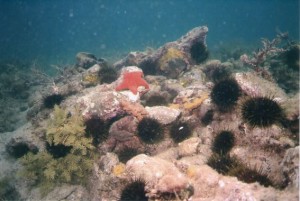
‘Mini-barrens’ such as this have their own characteristic features
This photo featured on page xxv of “Ecology of Australian Temperate Reef – The Unique South”, along with the caption “Mini-barrens formed by the purple urchin Heliocidaris erythrogramma in SE Spencer Gulf (photo Steve Reynolds)”.
I took this photo during my dive on the left hand (western?) side of Magazine Bay, South Australia in 2007. It is one of several photos that I took of purple sea urchins during my dive:-
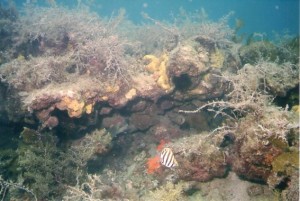
There seem to be a couple of purple sea urchins in this photo
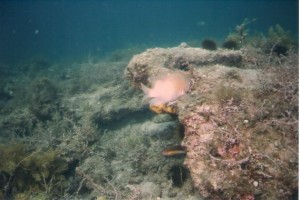
There are even more of them in this photo
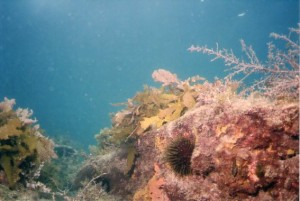
A close-up shot of one of the urchins
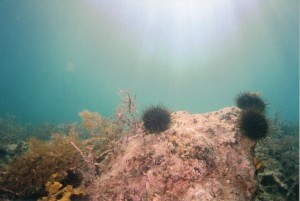
A group of three urchins bathed in sunlight at the top of a rock
As stated in my article Sea urchin barrens and mini-barrens, Chapter 12 in “Ecology of Australian Temperate Reef – The Unique South is titled “Effects of sea-urchins on benthic habitats”.
“The part of Chapter 12 which discussed the purple urchin Heliocidaris erythrogramma states, “Effects of purple urchin grazing – The variable grazing behaviour of the purple urchin has long puzzled biologists in southern Australia. In some place they graze algal populations destructively, creating mini-barrens, and in other areas they have no obvious effect at all.”
Sea urchins and barrens are also discussed in Chapter 11 of “Ecology of Australian Temperate Reef – The Unique South” (“Echinoderms”). Purple urchins are discussed on page 246 and a growth curve “for purple urchins living in barrens and those in algal forests in eastern Tasmania” is given in Fig.11.2.
Barrens are discussed in some more detail on page 248, saying “Feeding fronts of the purple urchin have occasionally been seen in NSW & Victoria . . . . The basic cause of the . . . . feeding fronts is probably enhanced local recruitment events, creating local barrens and a shortage of food.”
It goes on to say, “In SE Tasmania, Pederson and Johnson (2008) examined the size of the purple urchin’s jaw within its Aristotle’s lantern in different habitats and found that urchins living in barrens possessed larger jaws than urchins that lived within nearby algal forests. In sea urchins, larger jaws are better able to rasp the substrate for food and so larger jaws are typically associated with habitats with very limited resources, as in barrens. The study is significant because it suggests that purple urchins living in barrens can adapt to the limited food supply there and can change their diet and rasp the substratum for crustose corallines more effectively than urchins living in algal forest habitats.”
Further, “The purple urchin does not move during daylight hours, but at night it may move about to graze. At Deal I. in eastern Bass Strait, tagged urchins started grazing at duck and moved randomly . . . within mini-barrens . . . but ceased moving after midnight.”
On page 249, the black urchin, Centrostephanus rodgersii is said to be “the dominant herbivore subtidally on eastern Australian coasts and is notorious for the extensive urchin barrens, devoid of macroalgae, that it creates on shallow reefs among macroalgal forests.”
Further, on page 250, “The black urchin lives both in barrens it creates and in fringe habitats, where algae are abundant.” It goes on to state, “Byrne et al (1998) examined its reproductive output in both habitats and found that in fringe habitats the urchin grew larger and, for equivalent sizes, also had two to three times the size of gonads. It also spawned over a longer period in fringe habitats than in barren habitat.”
And then, “. . . authors examined growth rates of individuals marked with tetracycline in barrens and macroalgal habitats, and showed faster growth and larger maximum size in the latter habitat, although variability was high . . . The tests and length of spines also differed between the urchins living in barrens and those living in macroalgae. The barren-dwellers grow longer spines and lighter tests, together increasing their resistance to predators, whereas the forest-dwellers have shorter spines and thicker and heavier tests . . .”
Further, on page 251, “Pederson and Johnson . . . concluded that intense fishing of rock lobster for well over a century had reduced the resilience of macroalgal beds to invasion of the region by the black urchin. Hence, intense fishing had contributed to a catastrophic shift to urchin barrens. – a consequence that calls for a strong ecosystem management approach to reverse the severe loss of predators. At night time the black urchin leaves its crevice and goes on grazing excursions, sometimes moving 5-10m in a night, although mostly it forages in a small area around its shelter. In large barren areas with higher densities, urchins tend to forage further than those in crevices with only a few individuals. . . . . At Deal I., the black urchins grazed within their barren, and by dawn they had returned to a crevice abutting or within the barren. The black urchin diet includes a variety of macroalgae, seagrasses, encrusting algae and invertebrates, and is strongly influenced by the algae and invertebrates available. In two choice experiments, in which black urchins were offered species of macroalgae, they showed distinct preferences for particular macroalgae, but these experiments were designed to test how their feeding might affect the adjoining macroalgae vegetation, not whether the urchins preferred encrusting species. In fact, gut analyses suggest that much of the diet is filamentous and encrusting algae. For example, at Deal I., where macroalgal forest surrounded small barrens, much of the food eaten was taken grazing. In the gut content analysis for that site . . . crustose corallines comprised 12% by volume of the food eaten, but 70% by dry weight.”
The commencing overview for Chapter 12, “Effects of sea-urchins on benthic habitats”, states “The black sea-urchin Centrostephanus rodgersii has had a dramatic effect on subtidal habitats in New South Wales and eastern Tasmania by grazing down macroalgal forests and creating extensive urchin barrens dominated by crustose corallines and a sparse encrusting fauna. In New South Wales, these barrens have existed at least since the establishment of the colony there, and studies have been directed towards description of the barrens and algal habitats, and their interrelations, and an understanding of the reverse process of recovery from barrens to algal forest. From the early 1960s, the black urchin has gradually expanded its range southwards across Bass Strait and down the east Tasmanian coast, creating at first ‘incipient barrens’ and, over time, more extensive ones. The process of destruction of algal forests and the negative effects on the ecosystem and inshore fisheries, notably abalone, are described, and it is suggested that a mutualism exists between the black urchin and encrusting corallines, in which populations of both animal and plant benefit from the creation of barrens.”
The overview goes on to discuss the purple urchin, Heliocidaris erythrogramma, saying that it “is also present in macroalgal forest habitats on exposed and sheltered coats throughout southern Australia. The effect of the species, however, varies with habitat. On exposed coasts, where algal drift is abundant, the urchin traps the drift and has no effect on surrounding algal communities. But, on more sheltered coasts in eastern and southern Australian (sic), where algal drift may be less abundant, the purple urchin will graze attached algae and produce ‘haloes’ or ‘mini-barrens’. These are patches of partly cleared rock of varying area, in which some, but not all, algae are grazed. The sometimes complex, reverse transition from barrens back to algal forest is described, and may depend on other factors. In some conditions, algal forests and barrens may constitute alternative stable states.”
“The introduction to Chapter 12 states that “Sea-urchins have long been known to have a pivotal role in the structure of benthic communities and have caused the deforestation of vast areas of algal forests in many parts of the world. For this reason, they have been sometimes called ecosystem engineers, because they can modify the structure of a benthic community.”
The introduction goes on to state “The destruction of algal habitats and their replacement by encrusting corallines was first noted in Japanese waters in 1830, and termed ‘isoyake’ (meaning burnt rock). . . . In Australia, isoyake areas have long been known on the coast of New South Wales, and variously called ‘white rock’, ‘urchin barrens’ or ‘barrens habitat’; they are thought to have originated from overfishing of urchin predators. Here, we simply use the term ‘barrens’, although the term ‘isoyake’ has priority, and the term ‘barrens’ is strictly a misnomer, because many species of crustose corallines and a diverse, cryptic fauna are present in them. But urchin barrens differ in size and in their characteristics, so we use the term ‘incipient barrens’ and ‘haloes’ to describe specific types and sizes of urchin-grazed patches.”
The next part of the chapter goes on to describe several kinds of habitat types that occur along the NSW coast. Deeper in the chapter, when discussing the purple urchin, mini-barrens are said to be sheltered and semi-sheltered locations where urchin densities are high (10-20 urchins per m-2 and the urchins graze much of the macroalgae in the vicinity, forming noticeable patches of partly cleared bottom around it. These areas are said to “differ markedly from the isoyake areas described in Japan, and from the incipient or late-stage barrens typically formed by Centrostephanus grazing. So, here we simply call them ‘mini-barrens’, because they have their own characteristic features, and typically retain some cover of crustose corallines and foliose algae. Such mini-barrens . . . are occasionally seen in inshore waters and sheltered bays of the South Australian Gulfs . . .”
Other urchin ‘barrens’ photos feature in “Ecology of Australian Temperate Reef – The Unique South”. Plate 33, next to my photo, also shows “Barrens formed by the black urchin . . .”. Plate 31, on the same page (xxv) shows “Four purple urchins, Heliocidaris erythrogramma, with different colours”*. There are also three black & white photos in Chapter 12 (Figs. 12.6, 12.7 & 12.14).
* (“Sea Stars of Australasia and their relatives” by Neville Coleman says that purple sea urchins come in five major colour forms and three different spine forms.)”
Chris Roberts has since told us that there is a lot we still do not know about urchin/barren dynamics. He says, “Although they are thought likely to have ‘always’ existed, to what extent is hard to know or figure out!”
He says that there have been some studies looking at the stability of urchin barrens over the last few decades. It is his belief that many (over half) of the barrens in NSW have remained stable, or fluctuated, over the last few decades, while the rest have gradually increased in size, resulting in an overall/average increase in barrens (for those studied).
My thanks got to Chris Roberts and David Muirhead for their assistance with the above details.

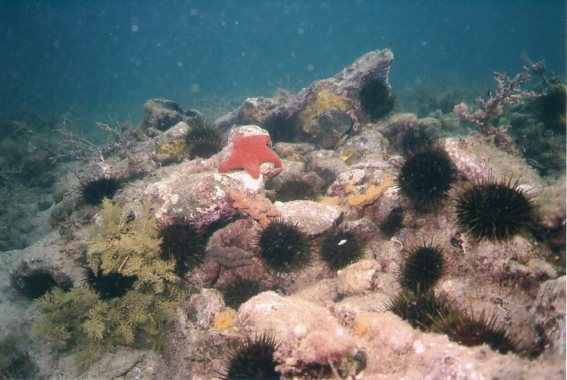
[…] More on Sea Urchin Barrens and Mini-Barrens […]